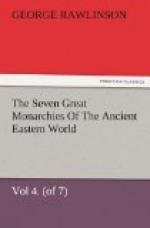The Euphrates ran through the town, dividing it nearly in half. Its banks were lined throughout with quays of brick laid in bitumen, and were further guarded by two walls of brick, which skirted them along their whole length. In each of these walls were twenty-five gates, corresponding to the number of the streets which gave upon the river; and outside each gate was a sloped landing place, by which you could descend to the water’s edge, if you had occasion to cross the river. Boats were kept ready at these landing-places to convey passengers from side to side; while for those who disliked this method of conveyance a bridge was provided of a somewhat peculiar construction. A number of stone piers were erected in the bed of the stream, firmly clamped together with fastenings of iron and lead; wooden drawbridges connected pier with pier during the day, and on these passengers passed over; but at night they were withdrawn, in order that the bridge might not be used during the dark. Diodorus declares that besides this bridge, to which he assigns a length of five stades (about 1000 yards) and a breadth of 30 feet, the two sides of the river were joined together by a tunnel, which was fifteen feet wide and twelve high to the spring of its arched roof.
The most remarkable buildings which the city contained were the two palaces, one on either side of the river, and the great temple of Belus. Herodotus describes the great temple as contained within a square enclosure, two stades (nearly a quarter of a mile) both in length and breadth. Its chief feature was the ziggurat or tower, a huge solid mass of brick-work, built (like all Babylonian temple-towers) in stages, square being emplaced on square, and a sort of rude pyramid being thus formed, at the top of which was the main shrine of the god. The basement platform of the Belus tower was, Herodotus tells us, a stade, or rather more than 200 yards, each way. The number of stages was eight. The ascent to the highest stage, which contained the shrine of the god, was on the outside, and consisted either of steps, or of an inclined plane, carried round the four sides of the building, and in this way conducting to the top. According to Strabo the tower was a stado (606 feet 9 inches) in height; but this estimate, if it is anything more than a conjecture, must represent rather the length of the winding ascent than the real altitude of the building. The great pyramid itself was only 480 feet high; and it is very questionable whether any Babylonian building




